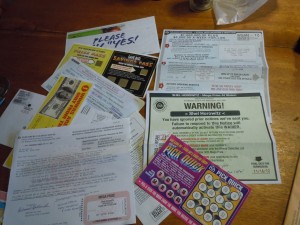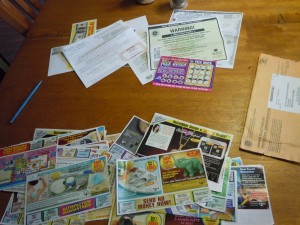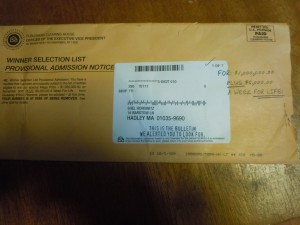Publishers Clearing House—Everything I Despise About Direct Mail, in One Envelope, Part 2
(continued from yesterday)

- Publishers Clearing House still believes in direct mail that scares people into action. The envelope and packet are full of legal-looking documents, dire warnings in big bold print, etc.
- The “involvement devices”—labels to pull off and attach, gold-covered panels to scratch off, very complicated instructions to follow exactly—are variations on the same stuff I remember from Publishers Clearing House mailers in the 1970s and 1980s. And they were old and tired even back then.
- Publishers Clearing House apparently never got the memo on credibility in marketing. Instead of using real credibility builders such as testimonials, they fill the mailing with official-looking layouts, fake stickers with bar codes, and language on the return form with language like “I am claiming eligibility…” Oh yes, and they’re still using celebrities, as they used the late Ed McMahon for many years (in fact, I first heard of Ed McMahon through PCH sweepstakes, and had to find out later that he was a TV star). Now, it’s Brian Williams.
Back in 2000, the PCH sweepstakes mailings inspired this quote in the Direct Mail section of my earlier book, Grassroots Marketing: Getting Noticed in a Noisy World:
Forget about glitzy, complicated sweepstakes offers, with seemingly dozens of different-sized papers, foils, stickers, and scratch-off cards; your production cost will be enormous before you even start. Besides, they cost you tons of money mailing to and following up on false prospects.
A simple, straightforward approach is far better. Use ordinary paper sizes and stocks, and win the prospect over through the strength of your offer—not gimmicks or packaging. You’ll stay within your budget, and target serious prospects, not a bunch of chiselers hoping for a million dollars from you, Ed McMahon, or the tooth fairy.
That was true when I wrote Grassroots Marketing, and even more true now.

- Of the 44 pieces of paper in the envelope, only 9-1/2 were actually related to the PCH sweepstakes and offer. The others, including the back of one of the Publishers Clearing House pages, were ads from other companies. Given that so much magazine content is available online, for free, that a whole generation will barely pick up a paper magazine any more, and that numerous other channels provide the information we used to get from general-interest magazines, it makes sense that Publishers Clearing House realized its business model had to change. Now they’re apparently in the business of delivering cheesy offers from other merchants—what could have been a good use of the partnership strategy I advocate, if the offer quality and targeting hadn’t been so pathetic.
- Geotargeting has become more sophisticated. One of the slips announces “SHEL HOROWITZ, THE SEARCH FOR A MAJOR PRIZE WINNER IN THE SPRINGFIELD-HOLYOKE TV AREA INCLUDES YOUR 01035 NEIGHBORHOOD!… There will DEFINITELY be a Major Prize Winner of $1,000.00 from Your Local TV Area, which includes your Zip Code!” (capitalization, punctuation, and underlining are exactly as they were in the original). So Publishers Clearing House is now matching zip codes against media markets, and guaranteeing at least one winner—note the SMALL dollar amount—in my media market (which contains dozens of zip codes).
- Technology isn’t perfect. My envelope contained two copies of a several-page ad bundle (one of several in the mailing)—and DID NOT contain the actual form to select magazines! Even if I’d wanted to subscribe, I couldn’t do so from this mailing.
I may get an onslaught of comments pointing out that Publishers Clearing House’s methods are obviously working, or they wouldn’t keep at it after all these decades. Of course they work! I freely grant that.
But to what effect? What’s the real benefit of developing a large list of purely transactional contacts who didn’t necessarily even buy—they entered a chance to win big bucks for free. Do these people have any loyalty? Has PCH done any segmentation other than geographic? Can they market to these people as individuals in any meaningful way?
The negative answer is obvious in the kinds of junk offers crammed into the rest of the PCH sweepstakes envelope: tchatchkes and trinkets and home repair products of dubious value—the sort of stuff that gets sold on late-night TV ads over obscure cable channels. It’s these clueless merchants that I actually feel sorry for.


